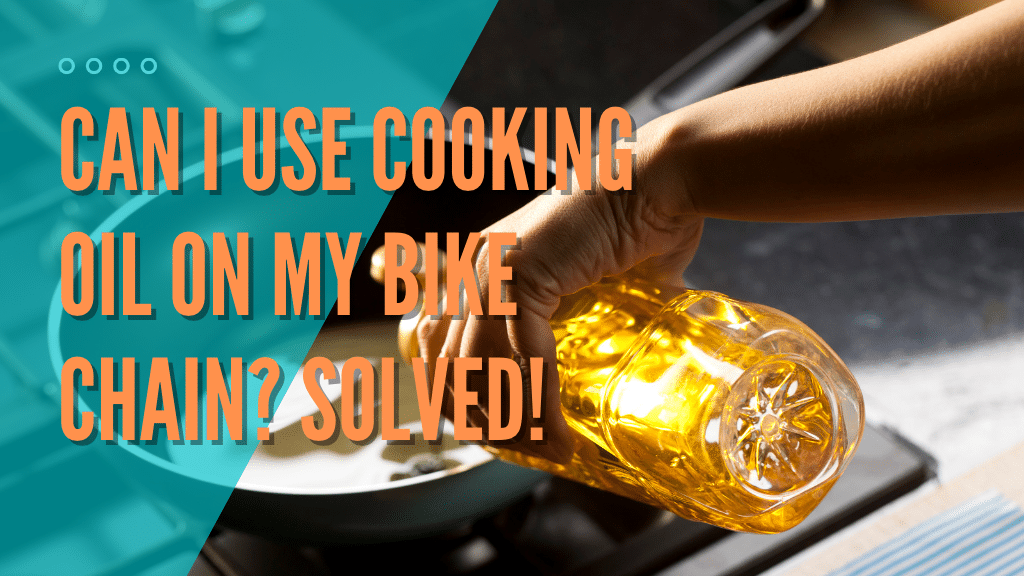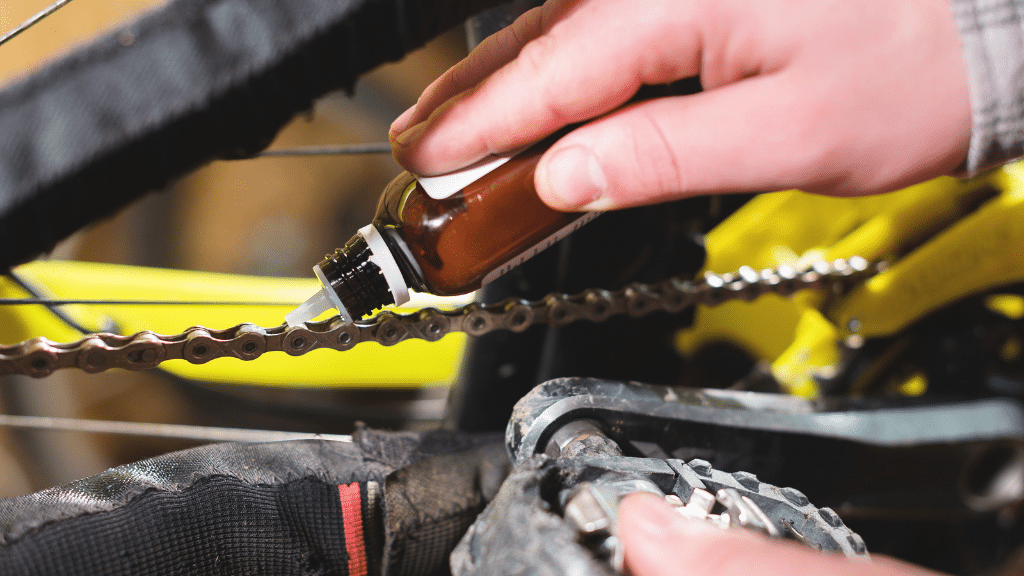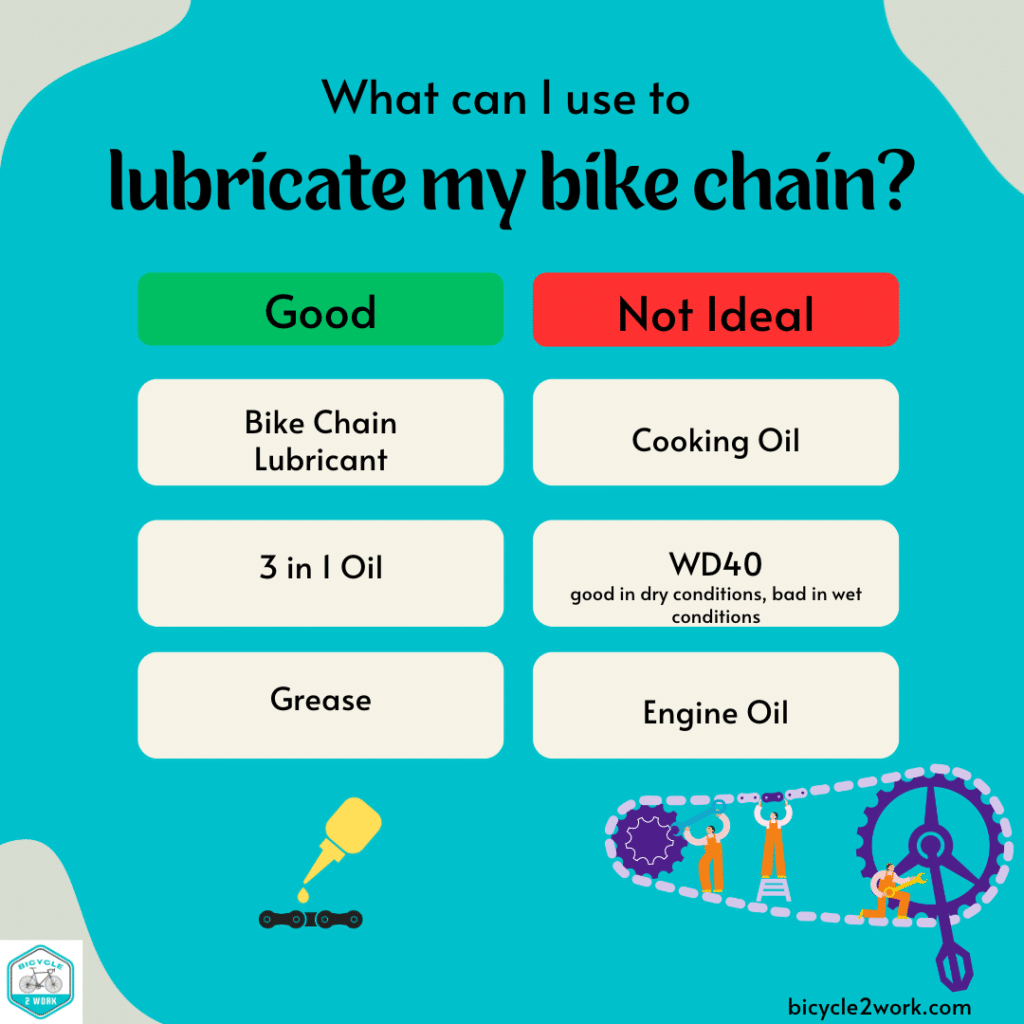This post may contain affiliate links. If you click an affiliate link and make a purchase, I may earn a commission. Also, as an Amazon Associate, I earn from qualifying purchases.--
Biking lovers know how exhausting it can be to keep a bike in top condition.
It is natural to move toward using something convenient, such as using cooking oil on your bike chains. Because, well, why not? After all, it’s something similar to what you’re used to. However, it will have very different effects on your bike than intended.
So can I use cooking oil on my bike chain? Regardless of how convenient it appears, it is best to not use cooking oil in place of the recommended chain lubricant, as it may actually harm your bike; by accumulating more debris and dust, and in other ways.
We will address all of the ways it affects your bike in this blog.
Before we jump into the whole argument let us educate you a little on the basics, so you can grasp the jargon of all the technical phrases.

What is Chain Lube, and how does it function?
Chain lube is perhaps the most frequently used accessory by bike owners, designed to keep one of the most mobile parts of your drivetrain, the chains, healthy and functional. It keeps the bike smooth and running while reducing the heat in the system.
Just like it is easy to slide on a slippery floor covered with oil, it is easy to ride a well-lubricated bike that does not halt your attempts at accelerating it. But why must we apply a lubricant? Why can we not skip it all? Let us answer that for you now.
Why Do Your Chains Require a Lubricant?
No matter what bike you use or the terrain you ride on, it is bound to face some wear and tear. The chains make forceful contact with your sprockets, wheels, and drivetrain each time you push down on the pedal. This interaction between your bike’s metals erodes your chain’s functionality.
A healthy chain is taut, rust-free, and slides effortlessly. A lubricant aids in the preservation of these characteristics by reducing total friction on the chains; making contact much smoother, and reducing the overall contact between your bike’s metals.
It would help if you also keep in mind that when we say chain lubricant protects your bike parts, we do not just mean the bike chains but every other aspect of your bike that is in contact with your chain; such as the sprocket or rear or front hub.
Besides its prominent role as a lubricant, chain lube is also imperative for maintaining a clean bike as it prevents dirt and grit from accumulating.
Moreover, it also acts as a shield against corrosion. Because the chains are subjected to such high levels of elemental stress, they are more prone to developing patches of corrosive pockets.
Please note that the technique used to oil your chain is highly important as it affects the performance and health of your bike. Watch this short clip to learn more about this procedure:
Now that we have established the necessity of chain lube let us move towards addressing the primary question of this blog.
How are Cooking Oil and Bike Lubricant different from one another?
Cooking oil consists of components that are essential for cooking. There is significant variation among different cooking oil types, but their properties are generally similar.
Refer to the table below for a rough idea of the differences in the nature and composition of cooking oil and chain lubricants:
| Chain Lubricant | Cooking Oil |
| Lacks acidity | Contains a lot of acids |
| Resistant to cold temperatures; does not solidify in winters | High freezing point; solidifies easily in a colder climate |
| Non-toxic to the environment | Somewhat toxic to biological organisms. Should never be consumed. |
| Contains graphite | Does not contain graphite |
| Resistant to degradation by the environment. | Easily degrades in the environment |
| Greatly resistant to oxidation | Oxidation occurs over time (source), at a much faster pace when compared to bike lube |
| Not sticky, repels dust and debris | Sticky, sticks to dust and debris |
| More viscous | Less viscous (source) |
| Inert: does not react chemically | Not inert: react chemically |
| Expensive | Cheap |
The Downside of Using Cooking Oil Instead of Chain Lube
First and foremost, cooking oil is for cooking. It is not designed to perform the tasks of regular chain lube. Since cooking oil lacks the central components in a chain lubricant, it cannot replace chain lube functionally.
Cooking Oil Lacks Graphite
The essential element of a good chain lube is graphite, which is absent in cooking oil. Graphite acts as a dry lubricant which prevents the accumulation of foreign particles.
Cooking Oil Increases the Accumulation of Debris on Your Bike
Chain lube is designed to minimize the collection of dust and debris inside your bike’s parts. Cooking oil does not perform this function adequately. In fact, it does the opposite of it. Debris gets easily stuck in a chain lubricated with cooking oil, which can do more harm than good; costing you a fortune.
Cooking Oil Contains Acid, Which Destroys Your Drivetrain
Acidity is an inherent property of most cooking oils since it helps in the process of cooking, but you do not need that to lubricate your bike. If you know any better, acid is what destroys metals (source), and you would like to keep it as far away from your bike as possible. Chain lube does not contain acid and is, therefore, safe to use. As the name states, it is designed to be used on chains.
Cooking Oil increases Dust on Your Bike
Using cooking oil can be counterintuitive since it attracts dust and debris. It will do the opposite of what you expect. The presence of debris will increase friction and cause micro-abrasions over your equipment, damaging the integrity of your bike parts.
Cooking Oil Degrades Quickly
Under normal conditions, cooking oil may last a while. Still, due to its chemical properties, it is very prone to degradation. The constant heat, friction, and environment are detrimental to cooking oil. It destroys cooking oil as it undergoes oxidation and loses its lubrication ability.
Chain lubricant can handle this stress much better and thus lasts longer than cooking oil. It is estimated that cooking oil can only carry you just over 50 kilometers before being rendered completely useless.
Cooking Oil is Quickly Washed Away
As mentioned earlier, cooking oil is much less dense than chain lube. This density plays a crucial role in its adherence to the mechanical parts of your bike. Let us take an everyday example to explain this.
Between honey and water, honey is very dense, while water is not. If you splash some honey and water on a wall, the water drips down much faster than honey. In fact, honey will take quite some time even to travel a minimal distance.
The same phenomenon applies here. Due to its increased density, chain lubricant can hold onto the bike parts much more efficiently than cooking oil.
Cooking Oil will Need Replacement Way Sooner
If you ever come to a situation where you have to use cooking oil, you will notice how easily it will vanish from your bike. Since it is washed away and degrades quickly, it must be replaced sooner. Therefore, chain lube has a longer lifespan than cooking oil.
Cooking Oil is Easy to Solidify
Cooking oil, as discussed in the previous heading, has a higher freezing point and, as a result, is less resistant to colder climates. Liquids are generally better lubricants since they form a thin layer between two surfaces in contact. Solids cannot perform this task adequately and will, therefore, fail to provide a sufficient medium for lubrication.
Chain lubricants can tolerate low temperatures much better than cooking oil and keep your bike functioning even in the coldest temperatures.
Using Cooking Oil Will Increase the Maintenance Required to Keep Your Bike Healthy
If you thought that since cooking oil is more readily available and is almost always found in your house, it is convenient to use it instead. But think again. Purchasing bike lubricant will be much more convenient since all the problems arising from cooking oil will be much more hectic and difficult to treat later on.
Overall, it is contrary to what one would intuitively expect because it is so similar in appearance to chain lube.

Can I use Cooking Oil in Emergencies?
There are better options for short-term use, but if you find yourself with nothing but cooking oil, go for it. Be sure to apply a sufficient amount, and ensure it is applied to all the parts equally. Due to its decreased viscosity, it will penetrate your chain easily.
Once you are done, remember that cooking oil will not last long distances, and you will have to replace it soon.
How to Clean My Bike After Using Cooking Oil?
After you have acquired your chain lube, it is best to replace the cooking oil as soon as possible. Clean the dirt and grit from your bike chains and other bike parts, such as the sprocket, drivetrain, or hubs.
Remove any previous cooking oil using a degreaser, ensuring none is left. The whole process of cleaning is outside the scope of this blog. Check out this blog for suggestions on how to clean your bike.
Alternatives: What can you use if you do not have chain lube? (This will also discuss things you should not use)
We understand there might be times when you cannot get your hands on a bike lubricant. In these circumstances, you can temporarily use something similar. Some of the things that you might use are:
Grease
It is perhaps one of the best alternatives since it mimics chain lube considerably. Grease usually goes into sealed parts, like ball bearings, wheels, and headsets, and not on open parts. It is not as formidable as chain lube, but it can be used if you do not have any.
3 in 1 Oil
The safest option out there is 3 in 1 oil. Created as a lubricant more than a century ago, it is still valid in today’s world. Now serving the purpose of a more general lubricant, it was initially used in bike chains.
It would be best to remember that even though it will work, bike innovations have made it more redundant. Newer formulae are now available, which will work eminently better.
WD40
Its task is to help you clean your bike, which means it will do the opposite of lubrication. While its manufacturer says it can act as a lubricant, it is, in reality, used to clean your bike and will strip your bike parts from any remaining lubricant that might be present.
For a comparison between WD40 and 3 in 1 oil, head to this blog.
Silicone Spray
If not for the part where it gets quickly washed away from the metals in your bike, it would be just the perfect alternative. Silicone spray is highly resistant to heat and provides lubrication and protection from corrosion.
Using a spray also means you can easily apply it to your bikes without getting your hands dirty, and be sure it penetrates every nook and cranny.
Machine Oil
This oil type provides similar features as chain lube but is less dense. It offers a low-friction environment and protection from corrosion. Still, it fails to protect from the dirt and grit of the terrain.
Engine Oil
Car oil is designed to function at higher cadence and temperature. Car or engine oil will not be as effective because it is dense and will not penetrate your chains enough. It will increase debris in your bike and increase the risk of damaging your chains. Therefore, using it as an alternative is not recommended unless you absolutely have to.
This was just an overview. If you wish to explore alternatives to bike chain lube in-depth, you may read this blog.

Conclusion
To summarize, cooking oil can be a low-cost alternative for providing the lubrication required to pedal your bike. However, it has numerous drawbacks that outweigh the advantages. There are countless suitable alternatives to cooking oil that are far superior and not harmful to your bike.
